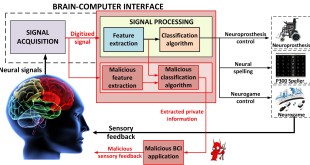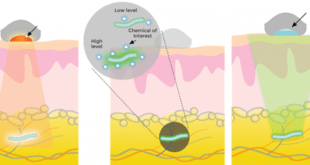Brain-Computer Interfaces (BCIs) are bidirectional devices that allow communication between the brain and external systems, such as computers. Every action our body performs begins with a thought, and with every thought comes an electrical signal. The electrical signals can be received by the brain-computer interface, consisting of an electroencephalograph (EEG) …
Read More »Cyber Threats Targeting Food and Agriculture Sector (FA) and Cyber Security
Throughout much of the world, food and beverage safety and security is a high priority. Concomitantly, the economics, societal robustness, and security implications of agriculture, foodstuffs and beverages are massive. Extensive quality measures are in place to prevent and mitigate threats from manifesting; outbreak and contamination detection and response systems …
Read More »Implantable Biosensors for Soldier’s health monitoring, diagnosis, and disease treatments
Biosensors, that is sensors that can detect parameters in a living being, are becoming more and more effective in several respects: detecting more and more parameters, becoming more and more sensitive, being able to co-exist for long period of time with the hosting organism to the point of becoming an …
Read More »Biomedical Informatics and Computational biology technologies require Supercomputers for projects like Covid-19 and Military
Computational biology is a branch of biology that aims to better understand and model biological structures and processes by utilizing computers and computer science. It entails the application of computer methods (such as algorithms) to the representation and simulation of biological systems and the large-scale analysis of experimental data. …
Read More »Integrated Pest Management (IPM) monitors Crop Pests & Diseases
Agriculture is a multibillion-dollar industry and one of the largest in the world, accounting for almost 1% of GDP in the UK, 6% in the US and 12% in Australia. It’s also set to be a growing industry, with the demand for food set to increase as the world approaches …
Read More »Healthcare management
The Healthcare industry can be defined as the collection of businesses and companies that provide healthcare services and products to treat patients. These treatments can come in the form of preventive, curative, rehabilitative and palliative care. Regardless, if a company is within the realms of healthcare, they will be focussing …
Read More »DARPA developed Battlefield Illusion for deception Electro-Optical Warfare
Magicians and generals have had a long-standing relationship – one that produced very real effects during wartime. Harry Houdini snooped on the German and the Russian militaries for Scotland Yard. English illusionist Jasper Maskelyne is reported to have created dummy submarines and fake tanks to distract Rommel’s army during World …
Read More »Optical and Laser Illusions
Optical illusions (or visual illusions) are tricks that your mind plays on you based on what you think you are seeing. The image that is being visually perceived is deceptive and does not tally with actual reality. So what you are seeing and what comes out after being processed by the …
Read More »Genome medicine technology trends and market growth
The genome is the complete set of information in an organism’s DNA. A DNA molecule consists of two long chains or strands. Each DNA chain contains a genetic code written using only four letters, which represent nucleotide subunits or bases: adenine (A), guanine (G), thymine (T), and cytosine (C). Their …
Read More »Smart farming transforming Agriculture by ICT technologies including AI, Robotics, IoT and Network technologies
Agriculture plays a fundamental role in the world both as a key source of livelihood and its role in the global food supply chain. It is a foundation of human survival. Agriculture is a multibillion-dollar industry and one of the largest in the world, accounting for almost 1% of GDP …
Read More » International Defense Security & Technology Your trusted Source for News, Research and Analysis
International Defense Security & Technology Your trusted Source for News, Research and Analysis



